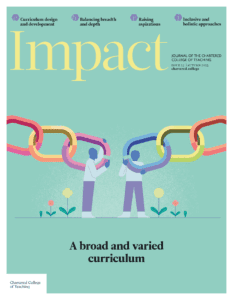Embedding structured oracy in the primary curriculum

LAUREN KEARNEY, SENIOR PRODUCT DEVELOPER, ENGLISH SPEAKING BOARD (INTERNATIONAL) LTD, UK
Introduction
If we accept that ‘reading and writing float on a sea of talk’ (Britton, 1970, p. 164), then it is remarkable that learners’ speaking and listening skills are not systematically developed with the same explicit focus as reading and writing. The Oracy Education Commission (2024, p. 40) notes that most teachers ‘lack tools for the diagnostic, supportive and formative assessment of oracy’ and are ‘not resourced to appraise progress in oracy and use this understanding to adapt and inform planning’. This concern is echoed in Ofsted’s English subject report (2024): ‘the curriculum for spoken language is considered in far less detail than the curriculum for reading and writing. It is viewed as a pedagogy rather than also being an object of study in itself.’
This case study examines what happened when a community primary school (with 56 per cent of learners eligible for pupil premiumAdditional funding for publicly funded schools in England to raise the attainment of disadvantaged pupils of all abilities in 2022/23) replaced an English unit that had a written outcome with a structured, externally assessed oracy programme in a Year 4 class of 59 learners. English Speaking Board (International) Ltd (ESB) is an awarding organisation regulated by Ofqual, and using the ESB Entry Level Award in Speech (Entry 2) qualification and preparation materials as a framework, Whitgreave Primary School introduced an ambitious model of speaking and listening instruction over eight weeks, culminating in a final spoken outcome.
We took a bold step
Leaders already place oracy at the forefront of school life, embedding Voice 21 (nd) teaching strategies and finding success. However, the lead teacher explained:
We wanted to also use the ESB qualification to have an actual focus on those specific skills in terms of a unit of progression… we’ve been given the creative control to meet the needs of the learners.
Teachers received training from ESB’s senior oracy assessor, equipping them with a clear understanding of assessment criteria and strategies for explicitly developing speaking and listening skills, as well as the underpinning ethos of ESB qualifications: learner choice and agency. The qualification requires learners to plan and deliver a short talk, introduce and recite a poem from memory, introduce a favourite book before reading a passage aloud, and actively listen and respond to questions. Lessons were structured to scaffold these skills through practice, reflection and feedback, treating oracy with the same rigour as reading and writing.
Staff expressed that external assessment added credibility, motivation and a sense of assurance:
It was incredibly valuable to have an outside expert confirm and validate that we’d pitched it correctly.
Research methods
The study used a mixed-methods design, combining quantitative and qualitative data to evaluate the impact of the ambitious change in curriculum design outlined previously. Teachers completed baseline and post-qualification assessments for each learner, evaluating specific skills, such as prosody or initiating and responding, using a three-point scale: ‘No’, ‘Sometimes’ or ‘Yes’. ESB conducted semi-structured interviews with teachers and teaching assistants on the day following the assessment. Quantitative data figures expressing rate of improvement include learners who were already at ceiling level for the skill.
Impact on listening and questioning
Learners engaged in targeted activities, such as parallel storytelling to practise active listening, ‘listening skills bingo’ to spot specific behaviours, and drama-based exercises experimenting with body language to signal interest or disinterest. Each activity was followed by a short reflection task, encouraging metacognition and ‘awareness of listening’ habits.
Staff reported that learners developed more purposeful, active listening and were better able to respond to others. This is echoed by quantitative data, where 57 per cent of learners improved in active listening, 45 per cent in asking relevant questions and 63 per cent in actively participating in conversations.
Passive listening shifted to more purposeful, dialogic interactions with teachers and peers. Learners were more likely to ask thoughtful follow-up questions and to make voluntary contributions:
Now, I’m getting nearly all children offering their ideas confidently and clearly… children will go, “Oh Miss, can I actually ask you a question first, please?” You can tell that they’ve listened carefully and then thought carefully about their questioning.
The focus on active listening skills also led to increased positivity, with learners more expressively affirming their peers, using non-verbal language to show engagement and encouragement:
My children have gone to the next level when it comes to positive praise… eye contact… huge smiles, two thumbs up and nods at the same time… listening to each other.
Teachers also saw a transformation in partner and group work, with monologic talk shifting to more dialogic discussions:
Group and partner work has become a lot more productive. It’s more of a two-way conversation now.
Impact on reading
Quantitative data revealed meaningful gains in reading-related tasks, including among learners who have found reading challenging:
- 34 per cent of learners improved their ability to read aloud at a reasonable pace
- 38 per cent improved their ability to read texts fluently
- 69 per cent improved their ability to read with prosody.
These gains were more pronounced for boys, where 38 per cent, 41 per cent and 75 per cent improved, respectively. Of learners with special educational needs and disabilities (SEND), 55 per cent improved their ability to read texts of an appropriate level fluently.
Reader’s theatre, speed-reading challenges (increase pace, retain clarity), repetition, and vocabulary familiarisation all supported reading accuracy and automaticity. Prosody was taught through modelling, identifying where readers use pace, pause, tone and pitch to create atmosphere, and through exploring dialogue – context clues, dialogue tags and vocabulary. The mechanics of sound production and creating meaning through sound were explored through co-constructive activities such as ‘say that shape’ and ‘sound scaping’:
We teach fluency, and we do other strategies like echo reading… but your resources, where we looked explicitly at pace, pitch and when to use it, that’s really stuck with the children. And now when we hear home readers, they’re applying it to that as well.
One teacher discussed how having a shared language around reading helped to achieve a clearer understanding of how to be fluent:
I don’t necessarily think that these are words that we [usually] teach to children. I think we go, “You need to be more fluent”… and they don’t know what that means. To be able to have these conversations with the children during reading… now that they’ve got that [vocabulary] in their bank is fantastic.
Learners’ motivation and enjoyment of reading were also affected, with one teaching assistantAn adult that assists a teacher in the classroom seeing learners who previously approached reading passively begin reading with more enthusiasm and intention:
Children who don’t find reading interesting or find it difficult – because of this new programme – are really excited about reading. The light was off, and now the light is on.
Learners exceeding expectations
Teachers commented on several learners who exceeded expectations in attainment and personal development. Quantitative data reflected these breakthroughs:
- 78 per cent of learners improved their ability to speak audibly in front of others
- 66 per cent were more able to participate in presentations
- 78 per cent were more able to choose and use appropriate register for the situation
- 78 per cent showed gains in using pace and pause to convey meaning.
One EAL (English as an additional language) learner achieving a distinction had earlier difficulties ‘in terms of structure… his ideas [could] sometimes be a bit incoherent’:
That chance to… look at the importance of structuring ideas before we speak, giving him that thinking time… with rehearsing and giving time to rehearse… gave him that confidence.
Further successes for the 10 EAL learners revolved around their metacognitive awareness of how language and sound are used to communicate meaning, not only linguistically but also socially and rhythmically. EAL learners thrived in areas typically presenting challenges:
- 80 per cent of EAL learners improved in reading prosodically
- 90 per cent improved in using pauses to create or support meaning
- 80 per cent improved in actively participating in collaborative conversations.
The attention paid in the explicit teaching methods to the musicality of spoken language may have enabled learners to take part more fluently by reflecting on not just what they were saying, but how they were saying it, developing expressive control. When supported to hear and feel the rhythm of English speech and reflect upon it, EAL learners may become more confident speakers and conversationalists.
Bower (2017) tells us that learners with EAL are also better able to engage with classroom discourse when their teachers (and, presumably, peers) have a better understanding of their home lives, interests and motivations. This has been strengthened in the classroom:
Children have learned so much about their friends… it’s that wider knowledge… that they all live very different lives. Some children have done speeches about their religion… some about what country they’re from.
Another area of success is for learners who typically have lower attainment in traditional assessment models, as well as those with SEND. One teacher described learners working below age-related expectations for literacy who achieved distinction grades in their ESB assessment:
Children who, in terms of reading and writing, are on the Year 2, maybe Year 3 curriculum… When doing the speech, their level of eye contact and confidence and expression in their voice – I’ve never seen them so animated.
Another learner who was new to the school, reading at CVC (consonant-vowel-consonant) level and having significant communication and writing difficulties, also found success:
This wasn’t just her talking. This was her consciously talking through the [skills] she picked up.
Despite this learner finding everyday tasks ‘incredibly hard’, the act of repetition, rehearsal and focus on rhythm and musicality in her choice of text meant that:
through repetition, consistency… having the opportunity to go over it… She’s achieved. Children of any level can access this… can pass, can achieve and can show growth.
There are a number of these success stories: a learner with a stammer who spoke fluently throughout her assessment – ‘she’s been able to shine right through this’ – and another learner with selective mutism – ‘She was smiling and was giving answers.’ Another result was that learners were better able to regulate their emotions. The National Literacy Trust (NLT, 2024) explains that ‘oracy skills enable young people to communicate their feelings effectively’ (p. 15).
Doing things like the emotion walks, and the silent drama pieces… they realised that they had to use their body to convey different emotions… I’ve found that’s helped with their regulation.
The NLT adds that without oracy skills, ‘young people may internalise their feelings, and become muted or absent from school’ (2024, p. 15). One such learner, who ‘finds it very hard to come to school… hard to socialise… not interacting’, also had a transformative experience:
He wants to come to school… he’s just a completely different child… and that’s through children listening to him.
This suggests that speaking and listening skills don’t benefit just the individual but the wider group, too.
Conclusion
This study shows how a carefully structured and assessed oracy intervention, anchored in explicit instruction, practice, reflection and purposeful performance, can unlock achievement in ways that traditional written assessment outcomes may not. For many, the experience provided a transformational shift, reframing the established paradigms of academic success:
I think this has given them the chance to realise they do have knowledge… and what they have in their head is also just as important being spoken as it is written.
External assessment was a crucial part of this transformation. The tasks and criteria provided a reliable, well-organised framework for instruction, supported by dedicated resources and training to aid the explicit teaching of underpinning speaking and listening knowledge and skills. The external assessment model meant that the work was treated with the rigour, preparation and validation that is often reserved for other forms of literacy. For learners, it brought a sense of pride and seriousness to their spoken contributions, as highlighted by their teachers.
Every single one of them came out of the assessment itself and said, “I want to do it again.” Every single one of them, as soon as they had finished, as soon as they walked out of the room.
Oracy is not a soft skill nor a by-product of classroom discourse. It is a powerful, equitable form of expression and learning that, when intentionally and explicitly taught and assessed, can give every learner the opportunity to thrive.
- Bower V (2017) Supporting Pupils with EAL in the Primary Classroom. Maidenhead: Open University Press.
- Britton J (1970) Language and Learning. Miami: University of Miami Press.
- English Speaking Board (International) Ltd (nd) Oracy teacher resources. Available at: https://esbuk.org/web/our-teacher-resources/speech-resources (accessed 22 April 2025).
- National Literacy Trust (NLT) (2024) Creating confident communicators: How the government can help every child find their voice. Available at: https://nlt.cdn.ngo/media/documents/Creating_confident_communicators_-_How_the_government_can_help_every_child_fin_4zRs95n.pdf (accessed 22 April 2025).
- Ofsted (2024) Telling the story: The English education subject report. Available at: www.gov.uk/government/publications/subject-report-series-english/telling-the-story-the-english-education-subject-report (accessed 22 April 2025).
- Oracy Education Commission (2024) We need to talk: The report of the Commission on the Future of Oracy Education in England. Available at: http://oracyeducationcommission.co.uk/wp-content/uploads/2024/10/Future-of-Oracy-v23-web-13.pdf (accessed 22 April 2025).
- Voice 21 (nd) Publications. Available at: https://voice21.org/publications (accessed 22 April 2025).










